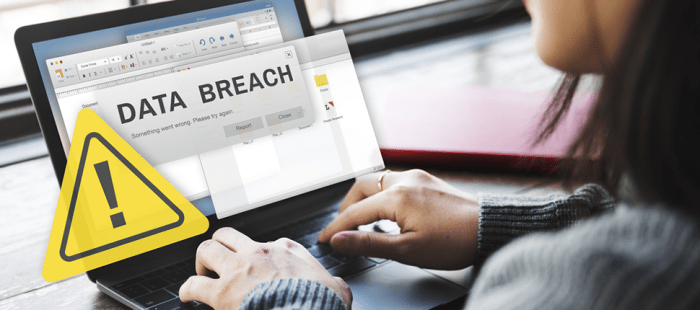How to verify a data breach? It’s a question that’s increasingly on everyone’s minds as data breaches become more frequent and sophisticated. From phishing scams to malicious software, the ways hackers can steal your personal information are becoming increasingly clever. But knowing how to verify a data breach is the first step in protecting yourself and taking action to mitigate the damage.
Data breaches can have serious consequences, from identity theft and financial loss to reputational damage. It’s crucial to be aware of the signs of a breach, understand how to verify it, and know what steps to take to protect yourself.
Understanding Data Breaches
In today’s digital age, data breaches are a growing concern for individuals and organizations alike. A data breach occurs when sensitive information is accessed or stolen by unauthorized individuals. These breaches can have severe consequences, ranging from identity theft and financial loss to reputational damage and legal repercussions.
Types of Data Breaches
Data breaches can occur through various methods, each with its own unique characteristics and vulnerabilities.
- Phishing: This involves attackers sending deceptive emails, text messages, or social media messages that trick users into revealing sensitive information, such as login credentials or credit card details. The messages often mimic legitimate communications from trusted sources, making them difficult to identify as fraudulent.
- Malware: Malicious software, or malware, can be installed on a device without the user’s knowledge. Once installed, it can steal data, monitor user activity, or grant unauthorized access to the device. Malware can be spread through various means, including email attachments, infected websites, and malicious advertisements.
- Insider Threats: These breaches occur when authorized individuals within an organization misuse their access privileges to steal or compromise data. Insider threats can be motivated by personal gain, revenge, or other factors.
- Hacking: This involves attackers exploiting vulnerabilities in software or network security to gain unauthorized access to systems and data. Hackers can use various techniques, such as brute-force attacks, SQL injection, and cross-site scripting, to bypass security measures.
Consequences of Data Breaches
The consequences of a data breach can be significant and far-reaching, affecting both individuals and organizations.
- Individuals: Data breaches can lead to identity theft, financial loss, and reputational damage. Stolen personal information, such as social security numbers, credit card details, and medical records, can be used for fraudulent activities.
- Organizations: Data breaches can result in financial losses, regulatory fines, legal liabilities, and reputational damage. Organizations may face lawsuits from affected individuals, regulatory investigations, and loss of customer trust.
Examples of Data Breaches
- Equifax Data Breach (2017): This breach affected over 147 million individuals in the United States, exposing sensitive information such as Social Security numbers, birth dates, and addresses. The breach resulted in significant financial losses for Equifax and led to numerous lawsuits and regulatory investigations.
- Target Data Breach (2013): This breach compromised the credit card information of millions of Target customers. The attack exploited vulnerabilities in Target’s payment processing system, allowing attackers to steal credit card data from point-of-sale terminals. The breach resulted in significant financial losses for Target and led to a decline in customer confidence.
Recognizing Signs of a Data Breach: How To Verify A Data Breach
Data breaches can happen to anyone, and it’s crucial to be aware of the warning signs so you can take action quickly. While it’s impossible to predict every data breach, there are common indicators that can alert you to a potential problem. Knowing these signs can help you protect your sensitive information and minimize the damage caused by a breach.
Unusual Email Activity
It’s important to be vigilant about unusual email activity. If you receive unexpected emails from unknown senders, especially those asking for personal information or containing suspicious links, it could be a sign of a data breach. Be cautious of emails claiming to be from legitimate organizations but with slightly altered domain names or misspelled words. Always double-check the sender’s email address and verify the legitimacy of the message before clicking any links or providing any personal information.
Unexpected System Behavior, How to verify a data breach
If you notice unexpected behavior in your computer or mobile device, such as slow performance, frequent crashes, or unusual pop-ups, it could indicate a data breach. Malicious software, often installed without your knowledge during a data breach, can disrupt your system’s normal operation. Additionally, be wary of changes in your device’s security settings, such as a new firewall or antivirus program being installed without your consent. These changes might signal unauthorized access to your device.
Security Alerts
Security alerts from your bank, credit card company, or other online services are a strong indicator of a data breach. These alerts often notify you of suspicious activity, such as unauthorized login attempts or unusual transactions. It’s important to take these alerts seriously and immediately investigate the situation. Contact your financial institution or service provider to report the suspicious activity and take steps to secure your accounts.
Monitoring Your Accounts and Systems
Regularly monitoring your accounts and systems for suspicious activity is essential to detecting potential data breaches. Enable two-factor authentication on all your online accounts, which adds an extra layer of security by requiring a second verification step, usually a code sent to your phone or email. Also, be sure to check your account activity logs for any unusual or unauthorized access. Look for logins from unfamiliar locations or devices, and be wary of any transactions you didn’t authorize.
Staying Informed About Known Data Breach Trends
Keeping yourself informed about known data breach trends is crucial for staying ahead of potential threats. Follow cybersecurity news and research to learn about common data breach tactics and vulnerabilities. This knowledge will help you identify potential threats and take appropriate precautions to protect your information. For example, if you are aware of a recent data breach affecting a specific organization, you should change your passwords and monitor your accounts for suspicious activity.
Verifying a Data Breach
You’ve spotted some suspicious activity, or maybe you received a notification about a potential data breach. It’s a scary situation, but before you panic, it’s crucial to verify whether you’ve actually been affected. This step helps you understand the extent of the problem and take appropriate action to protect yourself.
Verifying a Data Breach
The process of verifying a data breach involves gathering information from different sources and comparing it to your personal data. Here’s a step-by-step guide:
- Check Official Sources: Start by checking reputable sources like the website of the company or organization involved in the suspected breach. Look for official announcements, press releases, or statements regarding the incident. Often, companies will provide details about the types of data affected and steps they are taking to address the situation.
- Contact Relevant Authorities: If you can’t find information on the company’s website, consider contacting the relevant authorities. This could include your local law enforcement agency, the Federal Trade Commission (FTC), or the Office of the Attorney General. They may have access to information about reported data breaches in your area.
- Monitor Online Databases: Several online databases keep track of reported data breaches. These databases often provide details about the company involved, the date of the breach, and the types of data compromised. Some popular databases include Have I Been Pwned and BreachDirectory.
- Utilize Credit Monitoring Services: Credit monitoring services can alert you to suspicious activity on your credit reports, which could be a sign of a data breach. These services can also help you freeze your credit, making it harder for identity thieves to open new accounts in your name.
Data Breach Notification Laws and Regulations
Data breach notification laws and regulations play a crucial role in informing individuals about potential data breaches. These laws require companies to notify affected individuals when a breach occurs. The notification process typically includes details about the nature of the breach, the types of data compromised, and steps individuals can take to protect themselves. Some examples of data breach notification laws include the California Consumer Privacy Act (CCPA) and the General Data Protection Regulation (GDPR) in the European Union.
Comparing Data Breach Verification Methods
| Method | Description | Advantages | Disadvantages |
|—|—|—|—|
| Company Notifications | Official statements from the company involved in the breach | Reliable source of information, often provides details about the breach | May not be comprehensive, may not be timely |
| Online Databases | Websites that compile data breach information | Easy to search, provide information from multiple sources | May not be updated regularly, may not be accurate |
| Credit Monitoring Services | Services that monitor your credit reports for suspicious activity | Can alert you to potential identity theft, can help you freeze your credit | Can be expensive, may not detect all types of data breaches |
| Contacting Authorities | Reaching out to law enforcement agencies or government organizations | Can provide official confirmation of a breach, may have access to additional information | May not be able to provide immediate assistance |
In a world where data breaches are becoming increasingly common, knowing how to verify a data breach is essential for safeguarding your personal information and protecting yourself from the potential consequences. By staying informed about the signs of a breach, utilizing available resources for verification, and taking prompt action, you can minimize the risks and ensure your digital security.
So, you think your data might have been compromised? First things first, don’t panic! Check your email for official notifications, look for suspicious activity on your accounts, and even consider using a data breach checker like Have I Been Pwned. But if you’re looking for a new investment opportunity, keep an eye on yellow a new vc firm from glovo founders and atomico investor is betting on southern europe.
They might be the next big thing, and who knows, maybe they’ll be able to help secure your data too!
 Standi Techno News
Standi Techno News

